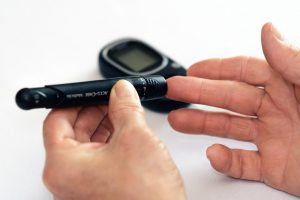There are three main types of diabetes, type 1, type 2, and gestational diabetes. Type 1 diabetes occurs when your body attacks its own pancreas with antibodies, therefore the inability to produce insulin. Gestational diabetes happens during a woman’s pregnancy. It creates a great risk to the unborn baby such as abnormal weight when the baby is born, breathing problems, and a higher risk of obesity and diabetes later in life. The mother may develop type 2 diabetes later in life because of gestational diabetes.

Type 2 diabetes is the most common one. It accounts for 95% of diabetes in adults, with numbers rising in children as well. Type 2 diabetes is when the pancreas does produce insulin, but not enough for the body’s needs. It can cause major health risks including heart disease and a stroke. There are many factors that can contribute to increasing a person’s risk of developing diabetes. Take this quick test to find out if you are at risk.
How Old Are You?
Less than 40 years (0 points)
40-49 years (1 point)
50-59 years (2 points)
60 years (3 points)
Family History: Does Your Mom, Dad or Siblings Have Diabetes?
Yes (1 point)
No (0 points)
Do You Have High Blood Pressure?
Yes (1 point)
No (0 points)
Are You Physically Active? (At Least 2.5 Hours of Exercise A Week)
Yes (0 points)
No (1 point)
Are You A Woman or Man?
Woman (0 points)
Man(1 point)
What Is Your Height and weight? (BMI)
4´ 10˝ 119–142 143–190 191+
4´ 11˝ 124–147 148–197 198+
5´ 0˝ 128–152 153–203 204+
5´ 1˝ 132–157 158–210 211+
5´ 2˝ 136–163 164–217 218+
5´ 3˝ 141–168 169–224 225+
5´ 4˝ 145–173 174–231 232+
5´ 5˝ 150–179 180–239 240+
5´ 6˝ 155–185 186–246 247+
5´ 7˝ 159–190 191–254 255+
5´ 8˝ 164–196 197–261 262+
5´ 9˝ 169–202 203–269 270+
5´ 10˝ 174–208 209–277 278+
5´ 11˝ 179–214 215–285 286+
6´ 0˝ 184–220 221–293 294+
6´ 1˝ 189–226 227–301 302+
6´ 2˝ 194–232 233–310 311+
6´ 3˝ 200–239 240–318 319+
6´ 4˝ 205–245 246–327 28+
1 point 2 points 3 points
*If you weigh less than the amount
in the left column: 0 points
Once you have written down the points, add them all up. If you scored 5 or higher, then you are at a high risk for developing type 2 diabetes. It is important to talk to your doctor if your score was high, and depending on your race, you may be at a higher risk. African Americans, Native Americans, Pacific Islanders, Hispanics/Latinos, Native

Hawaiians, and Asian Americans are at a higher risk for type 2 diabetes because it is most common among these races.
If you believe you are at high risk for diabetes, or even moderate risk, bring it up to your doctor. Get your blood sugar levels checked at the doctor’s office, and as often as you need to. There are different screenings and tests your doctor can run to make sure you are not at risk of developing diabetes. If you do have diabetes, or are a high risk, then your doctor can talk about treatment and prevention. Eat a well balanced diet, exercise 3-4 days a week, and watch your weight in order to avoid diabetes.